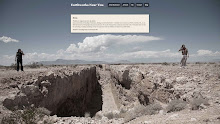
JR, August 2005
First Pulse Project posted several photographs a few years back.
I remember the salt brine sticking to my shoes for days. If my toes escaped my sandals, they were promptly scraped on the sharp salt deposits. As much as I wanted to submerge myself in the water, planting myself in the middle of the artwork, I knew that I was camping that night a few hundred feet away and had no fresh water to wash away the salt. It was a hot August day and my skin turned as pink as the color of the water. Later on I would see the largest snake of my life when climbing the hillside to get a better view of the thunder storm rolling in. The next morning, the Jetty was covered with white foam.
Jerry Saltz wrote this article in the
Village Voice in September 2006, 13 months after my visit. Watching the naked guy swim near the Jetty was a little too close to home.
"On Friday, September 15, the exact day that Utah's high-desert summer flipped into harsh mountain winter, I finally got to see a work of art that had previously only existed for me in the imagination and as a photograph. I went to see Robert Smithson's touchstone earthwork, Spiral Jetty.
Smithson's signature work was built in April, 1970, for around $8,000. Made of huge boulders and masses of dirt deposited (under Smithson's watchful eye) by a small team of construction workers using bulldozers and dump trucks, the sculpture stretches about 1,500 feet from the shore at Rozel Point into the Great Salt Lake, in a long spiral configuration, a sort of arm making a curly fist. While it was built just above water level, from around 1974 until late 2002, Spiral Jetty has been underwater.
Recent reports placed it above water level again, so I went to see for myself. After three hours of driving north and west from central Salt Lake City and almost turning back at the last minute because the dirt road we were navigating was almost washed-out, Spiral Jetty came into plain view.
Because of the weather, the driving rain, the lighting bolts across the shore, and something else I'll mention shortly, my first thoughts were a clutter of Edgar Allan Poe horror stories and Caspar David Friedrich paintings. The lake water was churning gunmetal gray and an unworldly salmon-pink shade. These extreme conditions not only made me put my boots on the wrong feet, they threw me into an ersatz sublime euphoria. I also felt fear. This, in turn, made me ashamed. I had come all this way to see a sculpture by an artist who is talked about as a theoretician, a scientist, and an aesthetician-geologist, and I was experiencing a romantic gush.
Then something amazing happened that made this rush make sense. Just off the main arm of the sculpture what I had thought was an abandoned car seat turned out to be a 6-7, 350-pound, totally naked man, alive, floating face up in the salt water. Whether he was taking his own spiritual cure or performing a self-baptism, he became a portal to think about this work of art. He was at once a device of awe and terror, as well as a representation of my inability to feel these feelings without shame and doubt. Either way I was freezing, wet, thrilled, terrified, and nervous that he was a mass murderer. I also took some great snapshots."
How many photographs will we take that will look just like
these?and will they compare to the tomato juice, milk, and salt combination made in the backyard of a house in North Portland?


















.jpg)
.jpg)


























